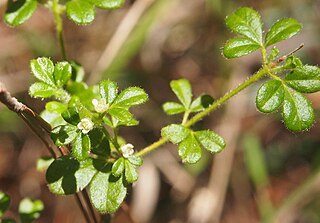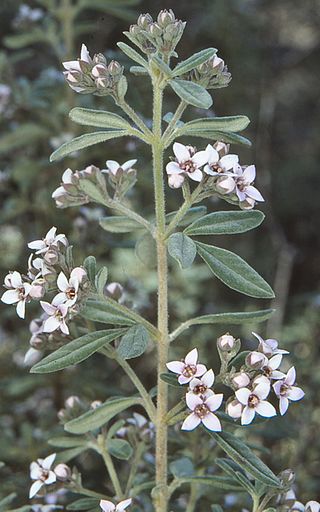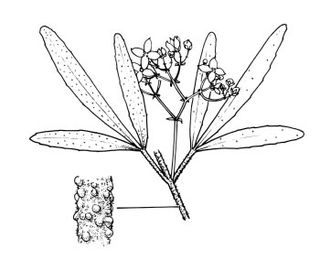
Zieria aspalathoides, commonly known as the whorled zieria, heath zieria, hairy zieria or heathy zieria, is a plant in the citrus family Rutaceae and is endemic to eastern Australia. It is a heath-like shrub with leaves that appear to be whorled and with pink flowers in groups of three, each with four petals and four stamens.

Zieria laevigata commonly known as smooth zieria, smooth-leaved zieria or twiggy midge bush is a species of flowering plant in the citrus family Rutaceae and is endemic to eastern Australia. It is an erect shrub with smooth, three-part leaves and pale pink or white flowers with four petals and four stamens. It grows in poor soil on rocky outcrops and flowers from late winter to spring.

Zieria adenophora, commonly known as the Araluen Zieria is a plant in the family Rutaceae and is only found near Araluen in the Southern Tablelands of New South Wales. It is a spreading shrub with small glossy, warty leaves and white or pink four-petalled flowers in spring. It is a rare plant with fewer than one hundred plants known from only one site.

Zieria arborescens, commonly known as the tree zieria or stinkwood, is a plant in the citrus family Rutaceae and is endemic to eastern Australia. It is a bushy shrub or small tree with branches that are ridged and scaly or hairy, at least when young. It has leaves composed of three leaflets and groups of flowers with four white petals, the groups usually shorter than the leaves.

Zieria compacta is a plant in the citrus family Rutaceae and is endemic to eastern Australia. It is an erect, bushy shrub with leaves composed of three leaflets, and white flowers with four petals and four stamens. It usually grows in rocky places on steep hills.

Zieria collina commonly known as hill zieria, is a plant in the citrus family, Rutaceae and is endemic to a small area in south-east Queensland. It is a large, spreading shrub with leaves composed of three leaflets, and small flowers with four white petals.

Zieria tuberculata, commonly known as warty zieria, is a plant in the citrus family Rutaceae and is endemic to a small area on the south coast of New South Wales. It is a shrub with warty, hairy branches and leaves and large groups of creamy-white, four-petalled flowers in late winter to spring.

Zieria minutiflora, commonly known as twiggy zieria, is a plant in the citrus family Rutaceae and is endemic to eastern Australia. It is a small, erect, twiggy shrub with leaves composed of three leaflets, and clusters of small white flowers with four petals and four stamens. It usually grows as an understorey shrub in eucalypt woodland.

Zieria caducibracteata is a plant in the citrus family Rutaceae and is endemic to New South Wales. It is a tall shrub or small tree with leaves composed of three lance-shaped leaflets. In early spring there are clusters of small white flowers with four petals near the ends of the branches.

Zieria cytisoides, commonly known as the downy zieria, is a plant in the citrus family Rutaceae and is endemic to eastern Australia. It is a bushy shrub with three-part, clover-like leaves and small clusters of pale to deep pink flowers with four petals and four stamens.

Zieria floydii, commonly known as the Floyd's zieria, is a plant in the citrus family Rutaceae and is endemic to the New England Tableland in New South Wales. It is an erect shrub with warty, hairy branches, three-part, clover-like leaves and clusters of creamy-white flowers with four petals and four stamens.

Zieria fraseri is a plant in the citrus family Rutaceae and is endemic to eastern Australia. It is a dense, bushy shrub with leaves composed of three leaflets, and white flowers with four petals and four stamens. It usually grows in rocky places on steep hills.
Zieria furfuracea is a plant in the citrus family Rutaceae and is endemic to eastern Australia. It is a shrub with three-part leaves and groups of large numbers of small white flowers, the groups shorter than the leaves. It grows on the coast and tablelands north from Wyong.
Zieria hydroscopica is a plant in the citrus family Rutaceae and is only known from a single state forest near Monto in Queensland. It is a small shrub with erect, wiry branches, three-part leaves and groups of large numbers of flowers, the groups smaller than the leaves and the flowers with four petals and four stamens. It is similar to Zieria smithii, differing only in the type of hairs on the branches and lower surface of the leaves.

Zieria ingramii, commonly known as Keith's zieria, is a plant in the citrus family Rutaceae and is endemic to a small area in central New South Wales. It is a slender, spindly, aromatic shrub with three-part, clover-like leaves and clusters of about seven white to pale pink flowers with four petals and four stamens. The species is only known from two state forests near Dubbo.
Zieria insularis is a plant in the citrus family Rutaceae and endemic to tropical north-eastern Queensland. It is an open, straggly shrub with wiry or spindly branches, three-part leaves and between one and a few white flowers with four petals and four stamens arranged in the leaf axils. It mostly grows near granite outcrops which are surrounded by forest or rainforest.
Zieria laxiflora, commonly known as wallum zieria, is a plant in the citrus family Rutaceae and is endemic to eastern Australia. It is an erect shrub with leaves composed of three leaflets, and clusters of about nine white or pale pink flowers with four petals and four stamens. It usually grows is coastal heathland.
Zieria rimulosa is a plant in the citrus family Rutaceae and is endemic to north Queensland. It is a shrub with leaves composed of three leaflets, and with white flowers with four petals and four stamens. Unlike many other zierias, its leaves are neither rough, glandular or densely hairy.
Zieria robertsiorum is a plant in the citrus family Rutaceae and is endemic to the wet tropics of far north-eastern Queensland. It is a shrub with leaves composed of three leaflets, and flowers with four white petals. The flowers are arranged in groups of up to ten which are no longer than the leaves.

Zieria southwellii is a plant in the citrus family Rutaceae and is endemic to eastern Australia. It is a large shrub or small tree with its leaves composed of three leaflets, and has groups of large numbers of flowers with four white petals, the groups shorter than the leaves. It grows near rainforest in northern New South Wales and far south-eastern Queensland.














